Madeline and Marion Fairbanks

British postcard. Photo: Thanhouser.
Madeleine (later Madeline) and Marion Fairbanks were born on the 15th of November 1900 in New York, U.S.A. They made their screen debut at Biograph in 1910 but they became stars at the Tanhouser company in 1912. Until 1916, Madeline and Marion Fairbanks were famous as the Thanhouser Twins and were featured in movies such as The Twins (1912), Cousins (1912), Their Great Beautiful Doll (1913), Twins and a Stepmother (1914), The Widow’s Mite (1914), The Flying Twins (1915) or The Burglar’s Picnic (1916). The two sisters also appeared separately in several films. After they had left Thanhouser, they turned to a stage career and notably appeared in the 'Ziegfeld Follies of 1917', 1918 and 1919. They also performed in Irving Berlin’s 'Music Box Revue' during the season 1922-1923. They came back twice to the movie world in The Beauty Shop (1922), in which their characters are named Coca and Cola, and On With the Show (1929). They retired in the 1930s. Marion passed away in 1973 and Madeline died in 1989.
Edna and Alice Nash
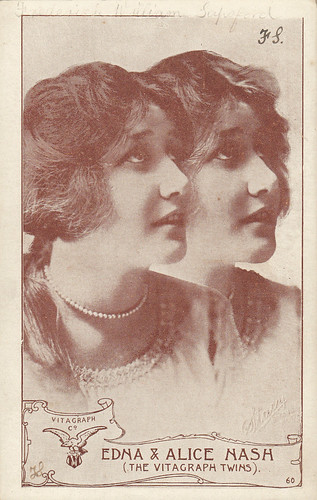
Vintage postcard, no. 60. Photo: Stacy / Vitagraph. Caption: The Vitagraph Twins.
Edna and Alice Nash were born on the 12th of October 1898 in New York, U.S.A. They made their screen debut at Vitagraph in Bunny and the Twins (1912). Until 1914, the two girls, who were known as the Vitagraph Twins, were featured in movies such as Two of a Kind (1913), Seeing Double (1913) or The Athletic Family (1914). In 1918, their last film, Love Watches, a Corinne Griffith vehicle, was released. From 1918 to 1921, they appeared in three Broadway musicals, produced by Charles Billingham at the Hippodrome Theatre. Edna passed away in April 1985. The date of Alice’s death is unknown.
The Dolly Sisters
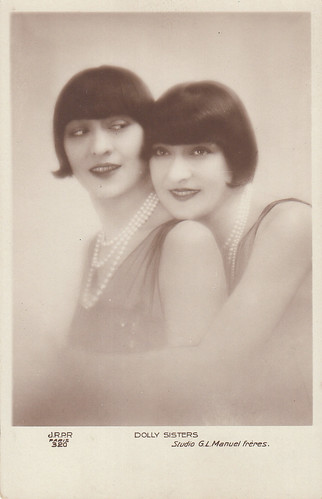
French postcard by J.R.P.R., Paris, no. 320. Photo: Studio G.L. Manuel frères. Collection: Marlene Pilaete.
Rozsika (later Rosie) and Janka (later Jenny) Deutsch were born on the 24th of October 1892 in Balassagyarmat, Hungary. The twins, who were to become famous as the Dolly Sisters, emigrated to the U.S.A. in 1905. In 1906, they began their dancing career and, in 1909, they appeared in their first Broadway show. They got their big break when they were cast in 'The Ziegfeld Follies of 1911' and soon got praise for their performance in 'The Merry Countess'. They also successfully toured with the musical 'Oh Look!' at the end of the 1910s. In 1915, they accepted movie offers: Jenny played an impoverished girl who becomes a famous dancer in Call of the Dance and Rosie was a beautiful temptress who steals Lillian Gish’s husband in The Lily and the Rose. In 1918, they starred in The Million Dollar Dollies, directed by Leonce Perret for Emerald Pictures. In the 1920s, their fame spread to London and Paris, where they performed at the best venues. They retired at the end of the decade. Jenny was severely injured in a car crash in March 1933. She was in a coma for several days. Doctors had to replace her stomach to a normal position and she then embarked on several plastic surgery operations on her face. She never fully recovered, physically and mentally, and committed suicide in 1941. In 1945, the highly fictionalised biopic The Dolly Sisters was released. Jenny and Rosie were respectively played by Betty Grable and June Haver. Rosie passed away in 1970.
Daisy and Violet Hilton
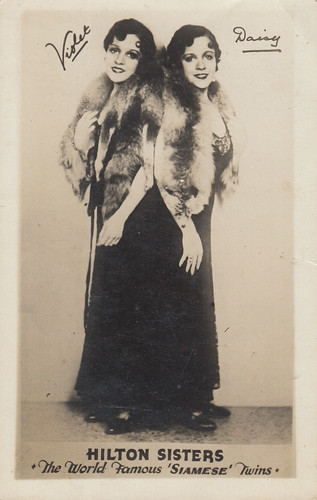
American postcard. Caption: Hilton Sisters, 'the World Famous Siamese Twins'.
Daisy and Violet were conjoined twins born on the 5th of February 1908 in Brighton, England. Their unmarried mother, Kate Skinner, soon abandoned them and left them at the hands of her employer, Mary Hilton, who became their legal guardian and who quickly realised the profits she could get from their public exposure. As they were looked upon as phenomenons, they were shamelessly exploited by this unscrupulous woman. When they were eight years old, they left for the U.S.A. and, over the years, became skilled musicians, singers and dancers. At the death of Mary Hilton in the 1920s, her daughter and her son-in-law took over Daisy and Violet’s management and continued to pocket most of the money the two girls, who were then high-paid entertainers in the vaudeville circuit, made from their shows. In 1931, a lawyer finally helped them to free themselves from their exploiters and they could at last reap the benefits of their work. In 1932, they made their screen debut in Tod Browning’s horror classic Freaks. Some twenty years later, they starred in the exploitation film Chained for Life (1951), in which one twin kills a scheming man who has wronged her sister. The justice is thus faced with a dilemma about the culprit: condemn her and, as a result, condemn her innocent sister too, or free her and leave her crime unpunished. Gradually, their popularity had faded and, as they never had a strong business sense, their finances dwindled. At the beginning of the 1960s, they found themselves stranded in Charlotte, North Carolina, abandoned by their touring manager and completely broke. They decided to settle there and found work in a grocery store. They died in 1969 from the Hong Kong flu.
The Dionne Quintuplets
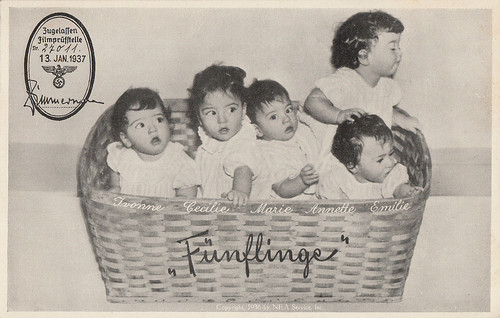
German promotional postcard by NEA Service, Inc., for the film The Country Doctor (Henry King, 1936). Caption: Quintuplets.
Yvonne, Cécile, Marie, Annette and Emilie Dionne were born on the 28th of May 1934 in Corbeil, Canada. They all survived, which was considered miraculous at the time, and attracted much attention. A few months after their birth, they were taken away from their family to be put first under the care of the Red Cross and, in March 1935, Ontario declared them wards of the Crown. Officially, they wanted to avoid them being commercially exploited and offer them harmonious growth. But it turned out differently as, paradoxically, Ontario would take unfair advantage of the twins, who never had a normal childhood and were considered public curiosities. They grew up in a hospital nursery especially built for them and their development was carefully studied by doctors. The place, soon called Quintland, would become a very lucrative tourist attraction for Ontario and would rival Niagara Falls in terms of economic profitability. Around three million people visited it to get a glimpse of the five phenomenons. Their image graced spoons, plates, postcards, calendars, fans, handkerchieves, playing cards, etc. and brands such as Palmolive, Quaker, Lysol or Colgate used them for their publicity. Dionne Quintuplets dolls were also produced by the famous Madame Alexander Doll Company. Hollywood also beckoned and 20th Century Fox starred them in The Country Doctor (1936), Reunion (1936) and Five of a Kind (1938). In 1943, Ontario finally gave the girls back to their parents but it was too late for them to establish strong ties with their family. They were unhappy and, when they were 18 years old, they left. Emilie died in 1954 and Marie in 1970. In 1998, following a lawsuit, Ontario had to pay the twins the sum of 4.000.000 Canadian dollars, in compensation for the harm suffered. In 2001, Yvonne passed away.
Mirtha and Silvia Legrand
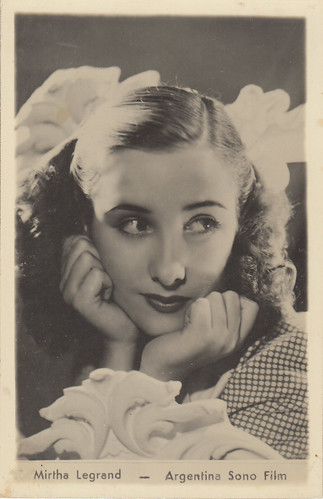
Argentinian postcard. Photo: Argentina Sono Film.
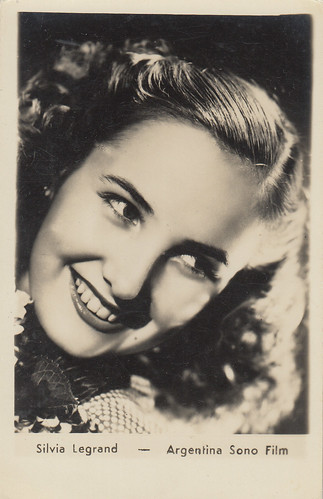
Argentinian postcard. Photo: Argentina Sono Film.
Mirtha and Silvia Legrand were born Rosa Maria Juana and Maria Aurelia Paula Martinez Suarez on the 23rd of February 1927 in Villa Canas, Argentina. They made their screen debut in small roles in a Nini Marshall vehicle, Hay que educar a Nini (1940) and quickly became famous. In the first half of the 1940s, Mirtha was featured in, notably, Los martes, orquideas (1941), Adolescencia (1942), El espejo (1943) or La pequena Senora de Perez (1944) and Silvia appeared in El tercer beso (1942), Su hermana menor (1943) or Siete mujeres (1944). The two sisters also co-starred in Sonar no cuesta nada (1941) and Claro de luna (1942). After El juego del amor y del hazar (1944), Sivia retired, following her marriage. Mirtha made a successful transition to adulthood and she was among the more brilliant stars of the Argentinian movie world thanks to movies such as Un beso en la nuca (1946), 30 segundos de amor (1947), La vendedora de fantasia (1950), De los ojos color del tiempo (1952), El amor nunca muere (1955), En la ardiente oscuridad (1958), La patota (1960), etc. From 1959 to 1962, Silvia came back to the screen in four movies, including Bajo un mismo rostro (1962), in which she co-starred again with her sister. Ten years later, she definitely ended her film career with Juan Manuel de Rosas (1972). Mirtha’s filmography ended with Con gusto a rabia (1963) and, from 1968 on, she embarked on an incredibly long and successful career on TV with her programs Almorzando con Mirtha Legrand and La noche de Mirtha. She became a true icon in her country. Silvia passed away in 2020.
Lee and Lyn Wilde
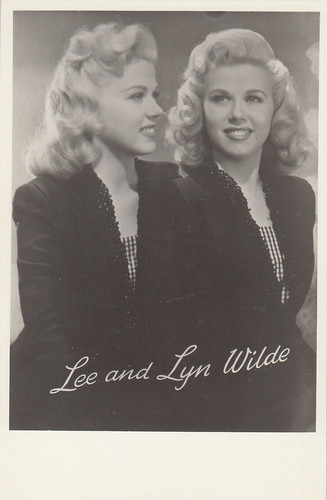
Dutch postcard by Takken, no. 3157.
Lee and Lyn Wilde were born Marion Lee and Mary Lyn Wilde in October 1922 in East St. Louis, Illinois, U.S.A. At the end of the 1930s, they performed on local radio stations and became band singers at the beginning of the 1940s. As themselves, they appeared in a few movies such as Juke Box Jenny (1942) or Presenting Lily Mars (1943). They got their first acting opportunities in Andy Hardy’s Double Trouble (1944) opposite Mickey Rooney and M.G.M. then starred in Twice Blessed (1945). They were also featured in Republic’s Campus Honeymoon (1947). They performed together for the last time onscreen in Look for the Silver Lining (1949) and Lee left the movie world to focus more on family life. From 1949 to 1953, Lyn continued her film career but the most important role she could get was in an Allan 'Rocky' Lane western, Sheriff of Wichita (1949). So, she also stepped out of the limelight to start a family. Lyn married Jim Cathcart in 1942 and Lee married his brother Tom in 1947. So, the twins became sisters-in-law. They both had two children from their marriage. The Cathcarts were musicians and, for the record, another brother, Jack, was married from 1941 to 1963 to Judy Garland’s sister, Mary Jane 'Suzanne' Gumm. Lee died in 2015 and Lyn passed away in 2016.
Pier Angeli and Marisa Pavan
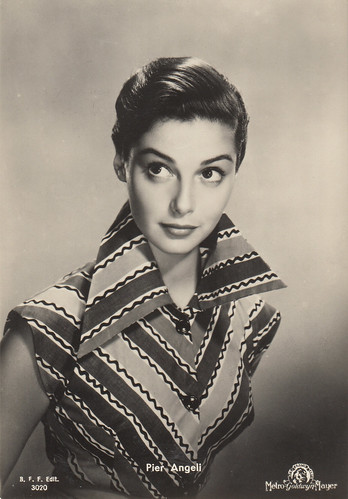
Italian postcard by B.F.F., Firenze, no. 3020. Photo: Metro Goldwyn Mayer.
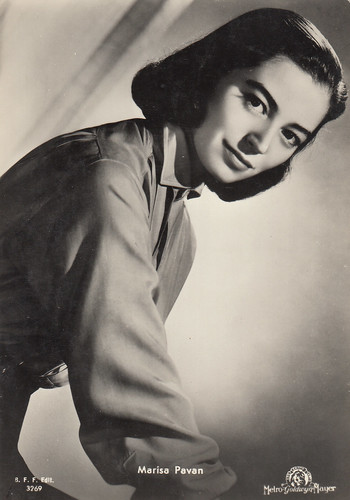
Italian postcard by B.F.F., Firenze, no. 3069. Photo: Metro Goldwyn Mayer.
Pier Angeli and Marisa Pavan were born Anna Maria and Maria Teresa Pierangeli on the 19th of June 1932 in Cagliari, Italy. Anna Maria was the first to become famous thanks to Domani è troppo tardi (1950), followed by Domani è un altro giorno (1951). She then went to Hollywood, where her name was shortened to Pier Angeli. In America, she notably starred in Teresa (1951), The Light Touch (1952), The Story of Three Loves (1953), Somebody Up There Likes Me (1956) and Merry Andrew (1958). In Europe, she also co-starred with famous French comedian Fernandel in Mam’zelle Nitouche (1954) and had an interesting part in the British movie The Angry Silence (1960). She had an affair with James Dean but her mother disapproved of it and they separated. In the 1960s, her career declined and most of her roles were less noteworthy. On the 10th of September 1971, she was given an injection of tranquillizer by a doctor and died from a cardiac arrest during her sleep, probably from anaphylaxis.
As Marisa Pavan, Maria Teresa made her screen debut in a supporting role as Robert Wagner’s love interest in John Ford’s What Price Glory (1952). 'Pavan' was the name of a Jewish officer her parents had hidden during World War II. She then came back to Italy to star in Ho scelto l’amore (1953). Her Hollywood films include Drum Beat (1954), Down Three Dark Streets (1954), The Rose Tattoo (1955), Diane (1956) and The Midnight Story (1957). She didn’t appear in many movies after 1960 but continued to perform on stage and on television until the beginning of the 1990s. The great love of her life was French actor Jean-Pierre Aumont, whom she married in 1956. In 2004, she became president of an association called U.R.M.A. which supported medical research on Alzheimer’s disease and which was dissolved in 2019. She currently lives in the South of France.
Isa and Jutta Günther

German postcard by Kunst und Bild, Berlin, no. A 104. Photo: N.
Isa and Jutta Günther were born on the 20th of May 1938 in München, Germany. They made their screen debut in Das doppelte Lottchen (1950), which made them famous. Their other films include Das Wirtin von Maria Wirth (1952), Der Erste Kus (1954) or Vier Mädels aus der Wachau (1957). Isa also played the young crippled girl Klara Sesemann in Heidi (1952) and Heidi und Peter (1955). The twin’s career ended with Der Sünderbock vom Spatzenhausen (1958) and they thereafter led a quiet family life.
Alice and Ellen Kessler
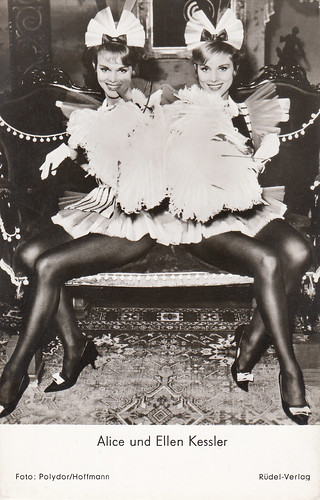
German postcard by Rüdel Verlag, no. 3836. Photo: Polydor / Hoffmann.
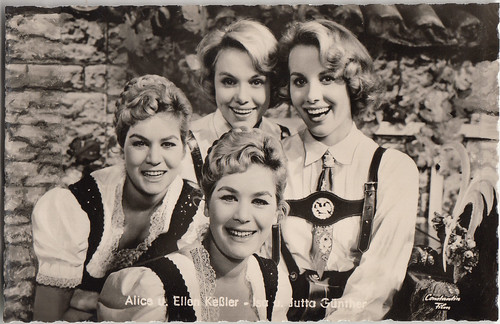
German postcard by Kolibri, no. 2763. Photo: Constantin Film. Alice Kessler, Ellen Kessler, Isa Günther and Jutta Günther. The two Germany’s most famous pairs of twins of their time co-starred in one film, Vier Mädels aus der Wachau (Franz Antel, 1957).
The Kessler twins were born as Alice and Ellen Kässler on the 20th of August 1936 in Nerchau, Germany. They were taught dancing since childhood and got their big break in the mid-1950s when they were hired at the Lido, one of the best-known cabarets in Paris. They soon became internationally famous and performed all around the world. From 1955 to 1964, they also appeared in about twenty movies, which were filmed in Germany, Austria, France and Italy. They include Solang’es hübsche Mädchen gibt (1955), Mit Rosen fängt die Liebe an (1957), Vier Mädels aus der Wachau (1957), Tabarin (1958), Mein Schatz ist aus Tirol (1958), Les magiciennes (1960), Rocco e le sorelle (1961) or Hochzeitsnacht im Paradies (1962). They also had a brilliant career on TV, especially in Italy, and made several records.
Pili and Mili
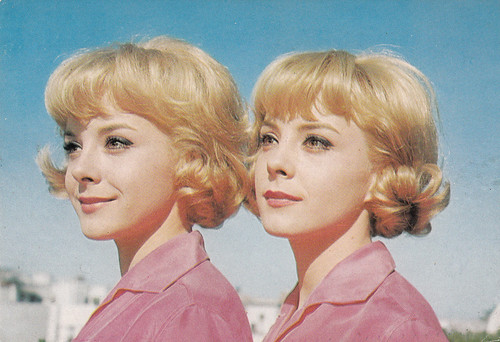
Spanish postcard by Oscarcolor, no. 354.
Pili and Mili were born as Pilar and Aurora Bayona Sarria on the 10th of February 1947 in Zaragoza, Spain. They became stars with their first movie Como dos gotas de agua (1964). In their native country, they were also featured in Whisky y vodka (1965), Dos chicas locas locas (1965), Dos pistolas gemelas (1966) and Agachate, que disparan (1969). They were also very popular in Latin America. In Argentina, they co-starred with Nini Marshall in Escandolo en la familia (1967) and they filmed in Mexico Un novio para dos hermanas (1967), Vestidas y alborotadas/Dos gemelas estupendas (1968) and La princesa hipie (1969). Mili, who had married in 1968, chose to retire after a last movie with her sister, La guerra de las monjas (1970). Pili appeared again in a few Mexican movies such as El club de los suicidas (1970) or El tesoro di Morgan (1971) and then went back to Spain. As Pilar Bayona, she continued her acting career on stage, on TV and, occasionally, in movies, without regaining the success she had met in the 1960s with her twin sister.
Text and postcards: Marlene Pilaete.
No comments:
Post a Comment